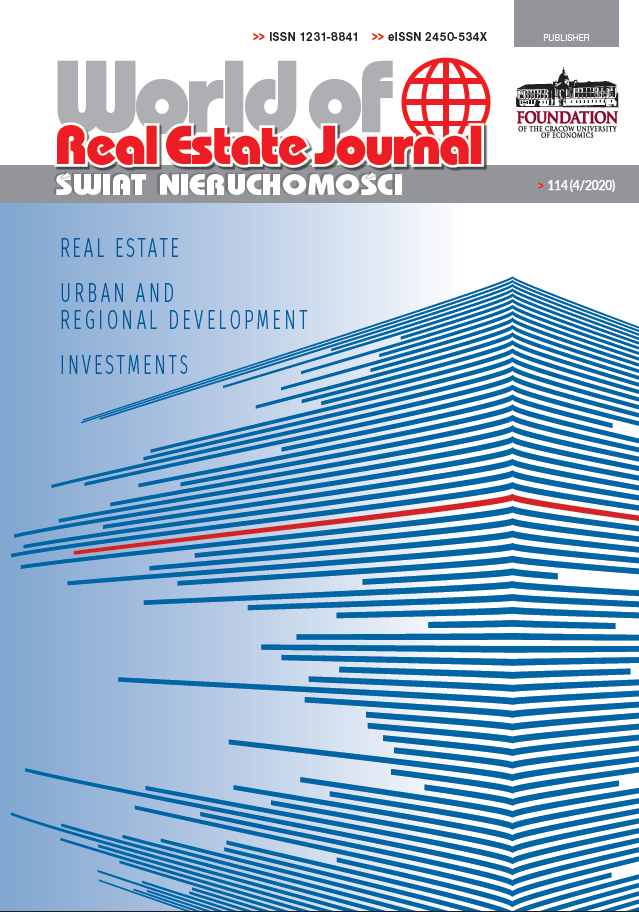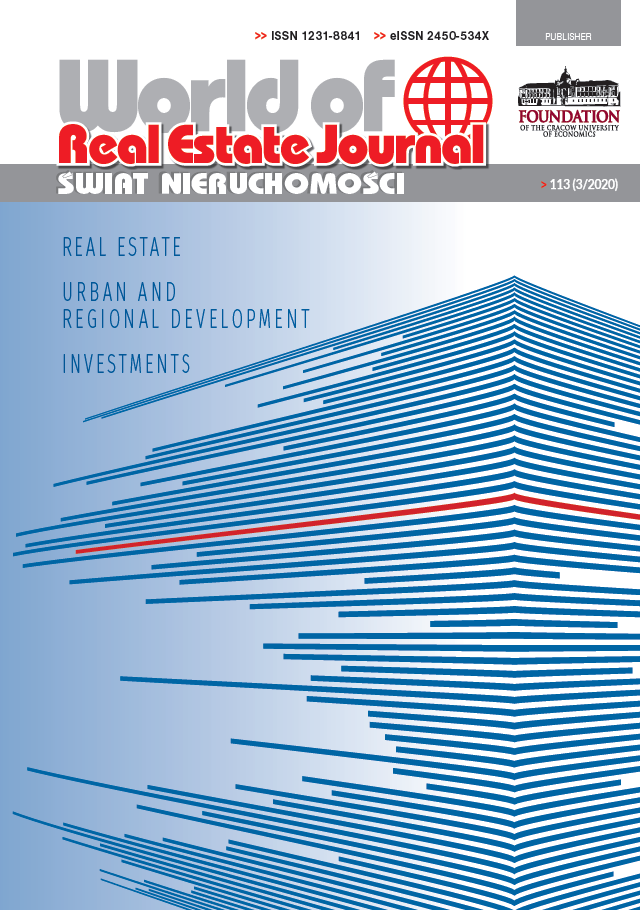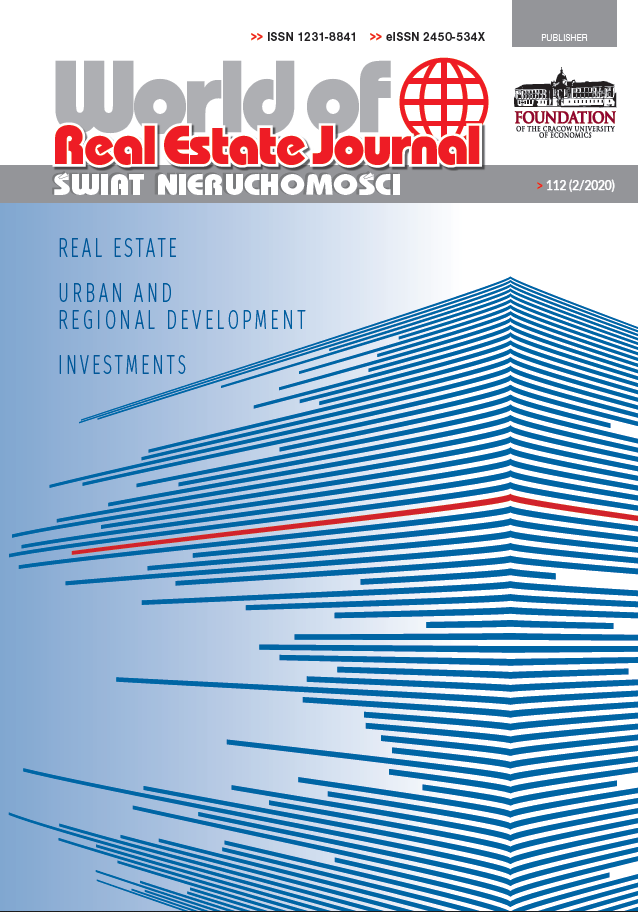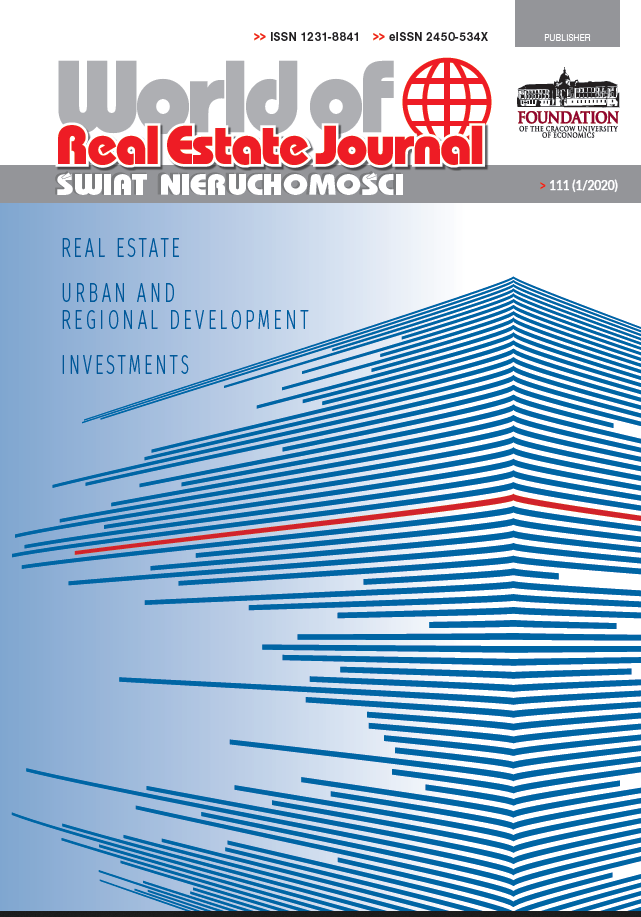World of Real Estate Journal 84 (2/2013) - Table of Contents
REAL ESTATE MANAGEMENT
1) Dariusz Felcenloben – The concept of an aerial parcel as a spatial object allowing registration of three-dimensional property rights – 3D cadastre
2) Dariusz Kloskowski – Problems of real estate economy in seaside municipalities where military objects are located
3) Marlena Jankowska, Mirosław Pawełczyk – Ownership in good faith as grounds for the acquisitive prescription of a predial servitude
MARKET
4) Justyna Brzezicka – The seasonal character of real estate market
5) Magdalena Frańczuk – Rent to Buy a Home – basic principles of the system. Comparison against the Polish law
PROBLEMS OF URBAN DEVELOPMENT
6) Janusz Jeżak, Maciej W. Wierzchowski – A Dilemma of urbanization: sprawling or compact growth
FINANCE
7) Beata Ziembicka – The building energy rating for the process of real estate valuation
8) Piotr Mirowski – Taxation of public-limited liability partnership companies in the aspect of developers’ tax optimization - conclusions of the Supreme Administrative Court resolution
9) Krzysztof Gradkowski – Method for determining value of earth structures in the context of local charges and taxes
LAW
10) Dominik Sypniewski – Building law reform: deregulation of construction permit
CHANGES IN REAL ESTATE LAW
11) Maciej J. Nowak - Clarification of a public purpose in The Real Estate Act
CONFERENCES
12) Michał Głuszak – 29th Conference of American Real Estate Society (Mauna Lani Bay, Hawaii, 9th - 13th April 2013)
ON THE PUBLISHING MARKET
13) Piotr Bartkowiak – Andrzej Jaki, „Mechanizmy procesu zarządzania wartością przedsiębiorstwa” – review
SUMMARIES
Dariusz Felcenloben - The concept of an aerial parcel as a spatial object allowing registration of three-dimensional property rights – 3D cadastre
Key words: real estate cadastre; 3D real estate; three-dimensional property rights; air parcel
Citation (APA): Felcenloben, D. (2013). Pojęcie działki powietrznej jako obiektu przestrzennego umożliwiającego rejestracje trójwymiarowych praw do nieruchomości – Kataster 3D. Świat Nieruchomości, (2(84)), 4-13.
DOI: 10.14659/worej.2013.84.01Dariusz Kloskowski - Problems of real estate economy in seaside municipalities where military objects are located
Key words: military objects; proving grounds; seaside municipalities
Citation (APA): Kloskowski, D. (2013). Problemy gospodarki nieruchomościami w gminach nadmorskich, w których zlokalizowane są obiekty wojskowe. Świat Nieruchomości, (2(84)), 14-19.
DOI: 10.14659/worej.2013.84.02Marlena Jankowska, Mirosław Pawełczyk - Ownership in good faith as grounds for the acquisitive prescription of a predial servitude
Key words: predial servitude; utility servitude; usucaption; utility company; good faith
Citation (APA): Jankowska, M., Pawełczyk, M. (2013). Posiadanie w dobrej wierze jako przesłanka zasiedzenia służebności gruntowej. Świat Nieruchomości, (2(84)), 20-25.
DOI: 10.14659/worej.2013.84.03Justyna Brzezicka - The seasonal character of real estate market
Key words: real estate market; calendar effects; the seasonal character of real estate market
Citation (APA): Brzezicka, J. (2013). Sezonowość rynku nieruchomości. Świat Nieruchomości, (2(84)), 26-31.
DOI: 10.14659/worej.2013.84.04Magdalena Frańczuk - Rent to Buy a Home – basic principles of the system. Comparison against the Polish law
Key words: rent of real estate; property purchase; flat; funding; government program; housing
Citation (APA): Frańczuk, M. (2013). System Rent to Buy a Home – „wynajmij, żeby wykupić”. Podstawowe zasady działania systemu, porównanie na tle prawa polskiego. Świat Nieruchomości, (2(84)), 32-37.
DOI: 10.14659/worej.2013.84.05Janusz Jeżak, Maciej W. Wierzchowski - A Dilemma of urbanization: sprawling or compact growth
• the implementation of space management monitoring;
• taking into account, in urban planning, the doctrine of organic planning;
• rational adaptation of foreign experience to Polish conditions;
• resolving the dilemma: dispersed urbanization - compact urbanization;
• elaboration of the concept of development based on dispersed built-up areas (Sprawling growth scenario) and compact built-up areas (compact growth scenario).
In the absence of financial means, the notations of the concept remains "on paper only". They were not followed by works allowing: the implementation of an integrated (cohesive and hierarchical) system of socio-economic and spatial planning neither the ordering of regulations meant to ensure the efficiency and universality of the spatial planning system, the institutional and quality strengthening of spatial planning
Key words: dilemma of urbanization; spatial planning; land for housing development; sprawling growth; compact growth
Citation (APA): Jeżak, J., Wierzchowski, M. W. (2013). Dylemat urbanizacji: wzrost rozproszony lub zwarty. Świat Nieruchomości, (2(84)), 38-43.
DOI: 10.14659/worej.2013.84.06Beata Ziembicka - The building energy rating for the process of real estate valuation
Key words: certificates of energy charakteristics; real estate; evaluation
Citation (APA): Ziembicka, B. (2013). Ocena energetyczna budynku w procesie szacowania wartości nieruchomośc. Świat Nieruchomości, (2(84)), 44-49.
DOI: 10.14659/worej.2013.84.07Piotr Mirowski - Taxation of public-limited liability partnership companies in the aspect of developers’ tax optimization - conclusions of the Supreme Administrative Court resolution
Key words: tax optimization; partnerships; real estate market; property; finance managing; tax law; holding; capital structure; tax structure; limited investment fund; tax saving
Citation (APA): Mirowski, P. (2013). Opodatkowanie spółek komandytowo akcyjnych w aspekcie optymalizacji podatkowej deweloperów – konkluzje z orzeczenia Naczelnego Sądu Administracyjnego. Świat Nieruchomości, (2(84)), 50-54.
DOI: 10.14659/worej.2013.84.08Krzysztof Gradkowski - Method for determining value of earth structures in the context of local charges and taxes
Key words: estimating value; excavation value; earth structures
Citation (APA): Gradkowski, K. (2013). Metoda określania wartości budowli ziemnych w kontekście opłat i podatków lokalnych. Świat Nieruchomości, (2(84)), 55-59.
DOI: 10.14659/worej.2013.84.09Sypniewski Dominik - Building law reform: deregulation of construction permit
Key words: construction permit; law reform; deregulation
Citation (APA): Sypniewski, D. (2013). Reforma prawa budowlanego a deregulacja pozwolenia na budowę. Świat Nieruchomości, (2(84)), 60-63.
DOI: 10.14659/worej.2013.84.10





















































